Caution: Use only SUPREME 11 or equivalent DOT 3 brake fluid from a clean, sealed
container. Do not use fluid from an open container that may be contaminated
with water. Improper or contaminated fluid will result in damage to components
or loss of braking, with possible personal injury.
Notice: Pressure bleeding equipment must be of the diaphragm type. It must have
a rubber diaphragm between the air supply and the brake fluid to prevent air,
moisture, and other contaminants from entering the hydraulic system.
Notice: Avoid spilling brake fluid on any of the vehicle's painted surfaces,
wiring, cables, or electric connectors. Brake fluid will damage the paint
and the electrical connections. If any fluid is spilled on the vehicle, flush
the area to lessen the damage.
Important: The presence of dark brake fluid is NOT an indication of brake fluid
contamination. The presence of dark brake fluid is caused by normal brake
system rubber component wear. One of the most common indications of brake
fluid contamination is brake system rubber component swelling and/or deterioration.
Flush the hydraulic brake system if there is any doubt about the condition
of the fluid in the system or if the brake fluid has been contaminated (mixed
with anything other than the recommended brake fluid).
Important: Ensure that the master cylinder brake fluid level does not drop to the
bottom of the master cylinder reservoir. You will be instructed to Inspect
and fill the master cylinder reservoir at times during this procedure. However,
the actual frequency of master cylinder reservoir filling REQUIRED will
depend on the amount of fluid that is released. If the brake fluid level
drops to the bottom of the master cylinder reservoir, start the bleed procedure
again at Step 1.
Tools Required
| • | J 29532 Diaphragm
Type Brake Bleeder |
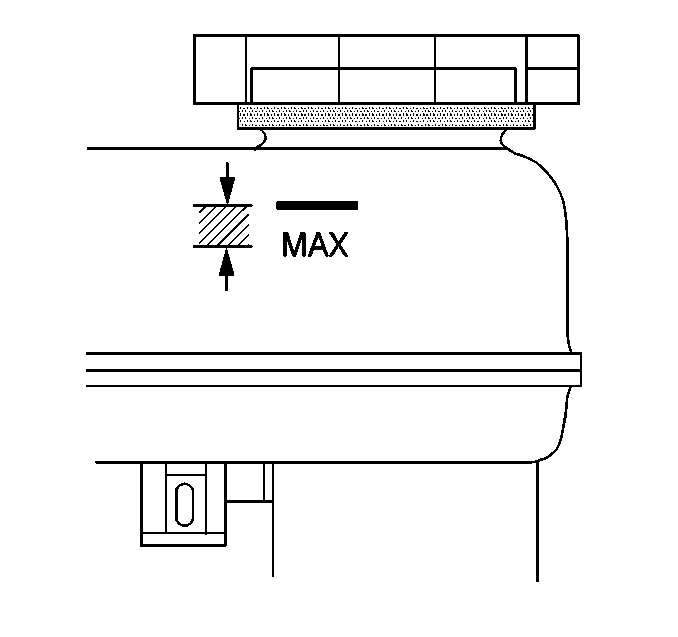
- Inspect and fill the master
cylinder
reservoir to the proper level as necessary. Refer to
Master Cylinder Reservoir Filling
.
- Assemble the following components to the J 35589
| 2.1. | 1/4 inch to 1/8 inch adapter |
| 2.2. | Assemble the 1/8 Inch 90 Degree Pipe Fitting Elbow to the |
| 2.3. | 1/8 inch quick connect fitting |
- Install the J 35589
to the
master cylinder reservoir.
- Connect the J 29532
to the J 35589
.
- Adjust the J 29532
to 35-70 kPa
(5-10 psi).
- Wait approximately 30 seconds, then inspect the entire
hydraulic brake system in order to ensure that there are no existing brake
fluid leaks. Repair any brake fluid leaks.
- Adjust the J 29532
to 205-240 kPa
(30-35 psi).
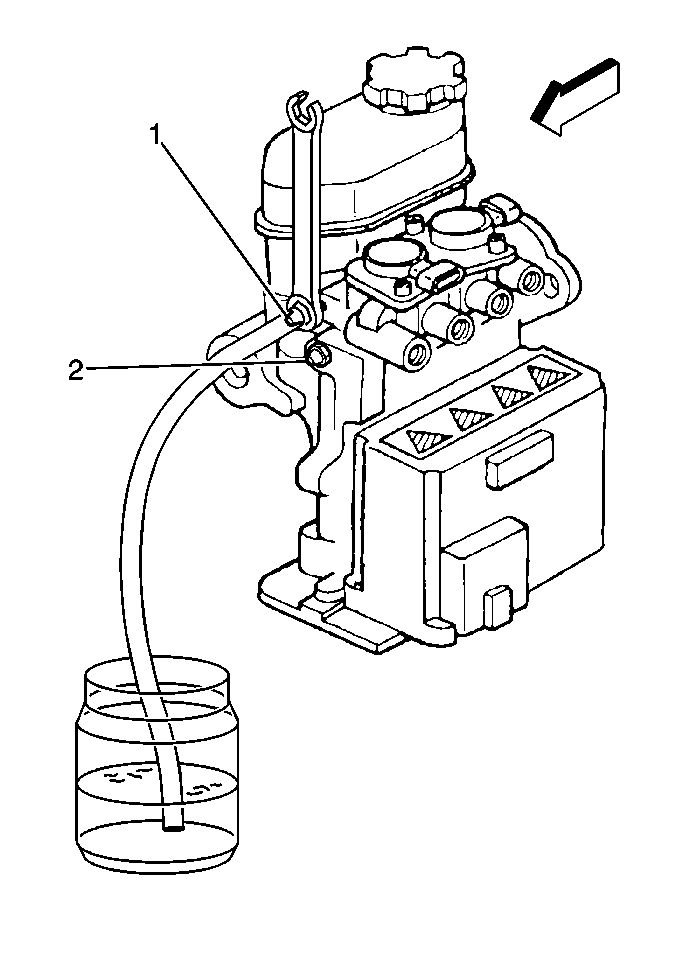
- Install a clear plastic
bleeder hose
to the ABS modulator REAR bleeder valve (1).
- Submerge the opposite end of the clear plastic bleeder hose in
a clean container partially filled with clean brake fluid.
- Slowly open the ABS modulator bleeder valve in order to allow
the brake fluid to flow.
- Close the ABS modulator bleeder valve when either of the following
is observed:
| • | Clean brake fluid is noticed |
| • | 118 ml (4 oz) of brake fluid is released |
- Remove the clear plastic bleeder hose from the ABS modulator bleeder
valve.
Tighten
Tighten the previously bled ABS modulator bleeder valve to 9 N·m
(80 lb in).
- Install the clear plastic bleeder hose to the ABS modulator FRONT
bleeder valve (2).
- Repeat Steps 9 through 11.
- Raise and suitably support the vehicle. Refer to
Lifting and Jacking the Vehicle
in General Information.
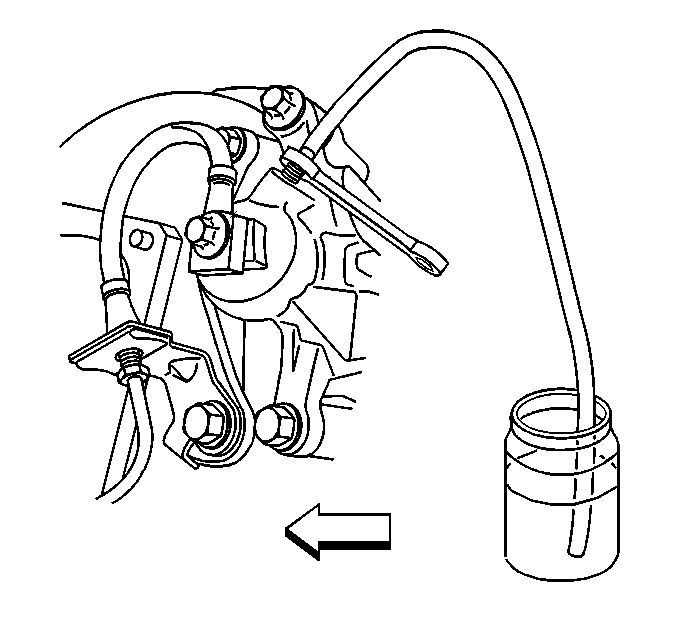
- Install the clear plastic
bleeder hose
to the RIGHT REAR bleeder valve.
- Submerge the opposite end of the clear plastic bleeder hose in
a clean container partially filled with clean brake fluid.
- Slowly open the wheel cylinder bleeder valve in order to allow
the brake fluid to flow.
- Close the bleeder valve when either of the following is observed:
| • | Clean brake fluid is noticed |
| • | 235 ml (8 oz) of brake fluid is released |
- Remove the clear plastic bleeder hose from the bleeder valve.
Tighten
Tighten the wheel cylinder bleeder valve to 11 N·m (97 lb in).

- Install the clear plastic
bleeder hose
to the LEFT FRONT brake caliper bleeder valve.
- Submerge the opposite end of the clear plastic bleeder hose in
a clean container partially filled with clean brake fluid.
- Slowly open the brake caliper bleeder valve in order to allow
the brake fluid to flow.
- Close the brake caliper bleeder valve when either of the following
is observed:
| • | Clean brake fluid is noticed |
| • | 235 ml (8 oz) of brake fluid is released |
- Remove the clear plastic bleeder hose from the brake caliper bleeder
valve.
Tighten
Tighten the brake caliper bleeder valve to 13 N·m (115 lb in).
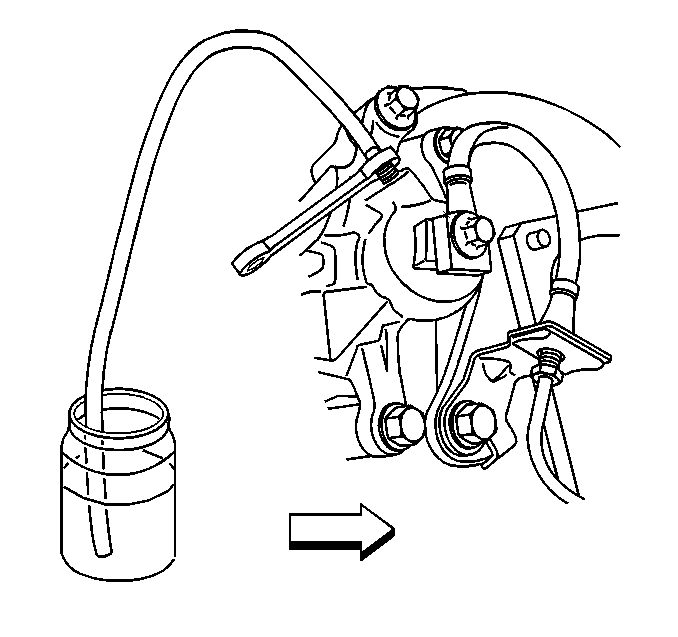
- Install the clear plastic
bleeder hose
to the LEFT REAR bleeder valve.
- Submerge the opposite end of the clear plastic bleeder hose in
a clean container partially filled with clean brake fluid.
- Slowly open the wheel cylinder bleeder valve in order to allow
the brake fluid to flow.
- Close the bleeder valve when either of the following is observed:
| • | Clean brake fluid is noticed |
| • | 235 ml (8 oz) of brake fluid is released |
- Remove the clear plastic bleeder hose from the bleeder valve.
Tighten
Tighten the wheel cylinder bleeder valve to 11 N·m (97 lb in).
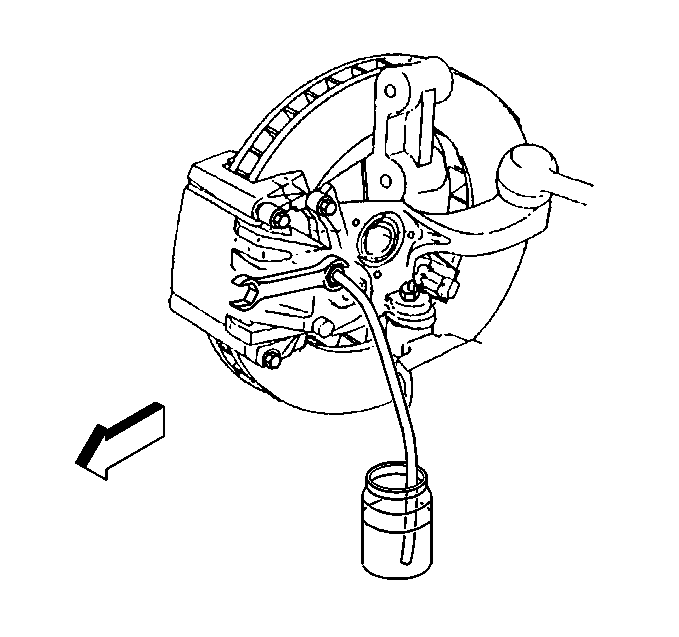
- Install the clear plastic
bleeder hose to the RIGHT FRONT brake caliper bleeder valve.
- Submerge the opposite end of the clear plastic bleeder hose in
a clean container partially filled with clean brake fluid.
- Slowly open the brake caliper bleeder valve in order to allow
the brake fluid to flow.
- Close the brake caliper bleeder valve when either of the following
is observed:
| • | Clean brake fluid is noticed |
| • | 235 ml (8 oz) of brake fluid is released |
- Remove the clear plastic bleeder hose from the brake caliper bleeder
valve.
Tighten
Tighten the brake caliper bleeder valve to 13 N·m (115 lb in).
- Lower the vehicle.
- Remove the J 35589
from the master cylinder reservoir.

- Inspect and fill the master
cylinder reservoir to the proper level as necessary. Refer to
Master Cylinder Reservoir Filling
.
- Install the master cylinder reservoir cap.
Important: After performing the initial hydraulic brake system flushing procedure,
replace all of the rubber components which have come in contact with contaminated
brake fluid:
- Perform the following steps:
| 40.3. | Replace or overhaul the brake calipers. Refer to the following: |







